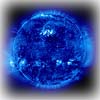
A huge solar prominance rises above the limb of the sun
in this image taken on May 1, 1999. For more information on
the sun go to the H-Alpha section or go to the Solar Section for
all sorts of solar-related photos and information.
Astronomy Education
The
Sun!

A huge solar prominance rises above the limb of the sun
in this image taken on May 1, 1999. For more information on
the sun go to the H-Alpha
section or go to the Solar
Section for
all sorts of solar-related photos and information.
Go to the H-Alpha Directory of Images for past and present
images of the sun in H-Alpha.
Take a look at observing the sun on Astronomy Day 1999.
For more on how we obtain these images go to the
Helios
I telescope page.
The Sun is an ordinary G2 star, one of more than 100 billion stars
in our galaxy.
Diameter: 1,390,000 km. (865,000 miles)
Mass: 1.989e30 kg
Temperature: 5800 K (surface) 15,600,000 K (core)
The sun moves through space with a speed of 150 miles per second. Even at this speed it takes the sun 250 million years to make one orbit of the galaxy. At a distance of only 93,000,000 miles, our sun is 270,00 times closer than the next nearest star, Proxima Centauri. Our sun is located about 30,000 light-years from the center of our Galaxy, the Milky Way.
The Sun is by
far the largest object in the solar system. It contains more than
99.8% of the
total mass of the Solar System (Jupiter contains most of the rest).
The Sun is personified in many mythologies: the Greeks called
it Helios and the Romans called it Sol.
The Sun is, at
present, about 75% hydrogen and 25% helium by mass (92.1% hydrogen
and
7.8% helium by number of atoms); everything else ("metals")
amounts to only 0.1%. This
changes slowly over time as the Sun converts hydrogen to helium
in its core.
The outer layers
of the Sun exhibit differential rotation: at the equator the surface
rotates
once every 25.4 days; near the poles it's as much as 36 days.
This odd behavior is due to the fact that the Sun is not a solid
body like the Earth. Similar effects are seen in the gas planets.
The differential rotation extends considerably down into the interior
of the Sun but core of the Sun rotates as a solid body.
Conditions at
the Sun's core are extreme. The temperature is 15.6 million Kelvin
and the
pressure is 250 billion atmospheres. The core's gases are compressed
to a density 150 times
that of water.
The Sun's energy
output (3.86e33 ergs/second or 386 billion billion megawatts)
is produced by nuclear fusion reactions. Each second about 700,000,000
tons of hydrogen are converted to
about 695,000,000 tons of helium and 5,000,000 tons (=3.86e33
ergs) of energy in the form of
gamma rays. As it travels out toward the surface, the energy is
continuously absorbed and
re-emitted at lower and lower temperatures so that by the time
it reaches the surface, it is
primarily visible light. For the last 20% of the way to the surface
the energy is carried more by convection than by radiation.
The surface of the Sun, called the photosphere, is at a temperature of about 5800 K. Sunspots are "cool" regions, only 3800 K (they look dark only by comparison with the surrounding regions). Sunspots can be very large, as much as 50,000 km in diameter. Sunspots are caused by complicated and not very well understood interactions with the Sun's magnetic field.
A small region known as the chromosphere lies above the photosphere.
The highly rarified
region above the chromosphere, called the corona, extends millions
of kilometers into space but is visible only during eclipses (left).
Temperatures in the corona are over 1,000,000 K.
 Solar
Links
Solar
Links
Information on the Sun courtesy Bill
Arnett / SEDS. Visit their
great informational pages!
Return To ICSTARS Astronomy.